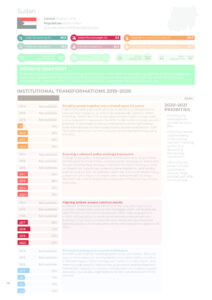Nutrition situation
Under five stunting (%)
36.6
Under five overweight (%)
2.3
Anaemia in women 15-49 years (%)
30.7
Under five wasting (%)
14.1
Low birth weight (%)
32.3
0 to 5-month-old exclusive breastfeeding (%)
61.5
Adolescent overweight (%)
Male: 7.4
/ Female: 16.2
Adult overweight (%)
Male: 19.7
/ Female: 36.1
Adult obesity (%)
Male: 3.8
/ Female: 12.4
Adult diabetes (%)
Male: 8.3
/ Female: 9.5
COVID-19 snapshot
To continue existing nutrition programming, and following World Health Organization guidelines, nutrition programme operational guidelines for nutrition teams delivering lifesaving nutrition interventions during COVID-19 were widely implemented. At the same time, TV and radio programmes raised COVID-19 awareness nationally.
Institutional transformations 2019-2020
Bringing people together into a shared space for action
Members of parliament have committed to ensuring that domestic resources are earmarked for nutrition, as well as tracking budget expenditure across health, agriculture and education sectors. Also, as a part of its mandate, the nutrition cluster relies on a humanitarian focused budget tracking system to gauge nutrition investments and gaps and undertake advocacy for more nutrition financing and programme delivery, in line with jointly identified priorities.Ensuring a coherent policy and legal framework
A range of key policy and legislative frameworks exist. They include the National Nutrition Policy, a Micronutrient Strategy, an Infant and Young Child Feeding Strategy, a National Nutrition Strategy, a Code on Breastmilk Substitutes, maternity leave legislation, and a policy brief on malnutrition. In addition, Sudan has a National Health Policy, a health-in-all-policies framework and a School Health Strategy. The MSP will work to ensure the enactment of these strong policies nationally.Aligning actions around common results
A revision of the national priorities is under way, drawing on the nutrition-related data, policies and strategies which will enable the identification of the common priorities. MSP-wide engagement in 2021 will take place to reach synchronised common nutrition priorities. Once common priorities and results are identified and agreed, advocacy, financing and costing and operational aspects will follow.Financial tracking and resource mobilisation
A revision of the national priorities is under way, drawing on the nutrition-related data, policies and strategies which will enable the identification of the common priorities. MSP-wide engagement in 2021 will take place to reach synchronised common nutrition priorities. Once common priorities and results are identified and agreed, advocacy, financing and costing and operational aspects will follow.2020-2021 Priorities
- Finalising the national multisectoral Nutrition Plan.
- Achieving a better understanding of the existing nutrition financing system and developing the tracking mechanism.
- Advocating for better nutrition outcomes at all levels. (high political level, MSP, communities).
Download

